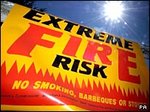Class 1 => Fires involving solid materials. (Usually organic matter such as paper, wood etc. This type of fire can be dealt with foam, water or extinguishers.)
Class 2 => Fires involving liquids or liquefiable solids.(Liquids or liquefiable solids such as oils, paints and fats. This type of fire can be dealt with extinguishers of foam. Carbon dioxide extinguishers are also best suitable for a fire involving electrical equipment.)
Class 3 => Fires involving gases. (Gases. Dry powder extinguishers can be used on Class 3 fires.)
Class 4 => Fires involving metals.(Metals such as aluminium, sodium, magnesium or potassium. Only specially trained personnel using special equipment can tackle such fires, fire extinguishers are not effective in this type of fires)
Class 5 => Fires involving cooking oils or fats.(Involving cooking fats and oils. Special extinguishers are available but it's best if specially trained people handles this type of fire.)



